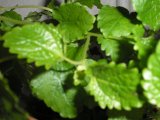Mint
Scientific name:
Mentha spp.
Family: Lamiaceae
 Photo by Jewel Kinilitan-Bissdorf
Photo by Jewel Kinilitan-Bissdorf
Plant parts used
Leaves
Mode of action
Against bacterial diseases
Formulations
| Materials |
Method of preparation |
How to use |
Target pests |
Mint extract
250 grams of leaves
2 liters of water
Grinder
Strainer
Pail
|
Grind the leaves to make into a paste
Add water
Stir well
and ready for use or strain it to have a clear extract
|
Spray on infected plants
thoroughly using water can or sprinkler
|
Bacterial leaf spots and other bacterial diseases
|
Standard procedures for the preparation and application of the plant extracts
- Select plant parts that are free from diseases.
- When storing the plant parts for future usage, make sure that they are properly dried and are stored in an airy container (never use plastic container), away from direct sunlight and moisture. Make sure that they are free from molds before using them.
- Use utensils for the extract preparation that are not use for your food preparation and for drinking and cooking water containers. Clean properly all the utensils every time after using them.
- Do not have a direct
contact with the crude extract while in the process of the preparation and during the application.
- Make sure that you place the plant extract out of reach of children and house pets while leaving it overnight.
- Harvest all the mature and ripe fruits before plant extract application.
- Always test the plant extract formulation on a few infested plants first before going into large scale spraying. When adding soap as an emulsifier, use a potash-based one.
- Wear protective clothing while applying the extract.
- Wash your hands after handling the plant extract.
Effect on humans
None known during the write-up, however take extra caution as extract maybe harmful to people with sensitive skin.
Effect on non-target organisms
None

